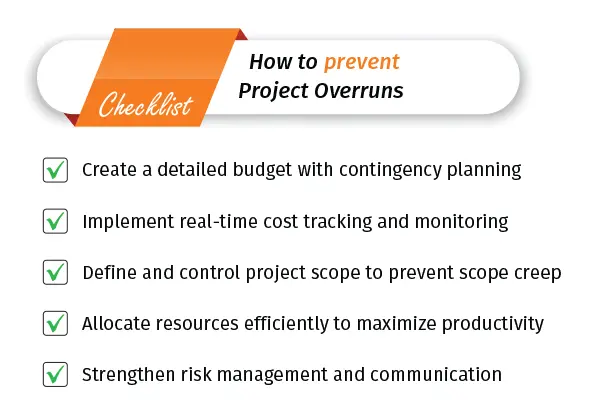
Effective project planning lays the groundwork for success yet challenges often arise beyond the initial blueprint. Among these hurdles, cost overruns in project controls stand out as a major issue and concern. Beyond the inherent complexities of large-scale projects, inadequate project management execution can lead to increased costs. A good project management team must swiftly identify potential sources of potential overruns early on and proactively address them. Implementing the right capital project management software can help you minimize these risks and keep your projects on track.
In this article, we will highlight the top causes of cost overruns and offer actionable strategies for preventing and managing them.
What is a cost overrun in project controls?
Cost overrun definition and basic formula
A cost overrun or budget overrun occurs when the actual cost of a project exceeds the initially estimated or budgeted cost, which was accepted as the cost basis for project execution. In other words, a cost overrun happens when a project ends up costing more than expected.
Calculating cost overruns allows you to measure how much a project’s actual expenses exceed its planned or budgeted costs. You can express a cost overrun either as a specific amount or as a percentage.
Cost overrun= Actual Costs – Budgeted Costs
Cost Overrun Percentage= (Actual Costs- Budgeted Costs)/Budgeted Costs*100%
If the actual costs are higher than the planned or budgeted costs, it indicates a cost overrun. Conversely, if the actual costs are lower, it results in a cost underrun, indicating spending less than planned.
Real-world example of a cost overrun
One of the most well-known examples of a cost overrun is the Sydney Opera House in Australia. While the project was approved in 1957 with an estimated budget of around AUD 7 million and a four-year timeline (BBC), it faced major design changes, technical challenges, and political debates during construction. As the unique sail-like design evolved, so did the engineering complexities and costs. The Opera House was finally completed in 1973 (10 years behind schedule) at a total cost of approximately AUD 102 million. This was more than 14 times the original estimate.
This historic overrun highlights how design changes, underestimated technical difficulties, and a lack of robust cost controls can dramatically impact a project’s budget and schedule.
Early warning signs of budget overruns
Keeping projects on budget requires close monitoring and early detection of potential issues. As your project progresses, watch for these key red flags:
- Lack of a well-defined and itemized project budget
- No contingency plan, making it difficult to manage unexpected costs
- Absence of real-time cost tracking and reporting tools
- Poor resource allocation plan, leading to inefficiencies and wasted spending
- Failure to establish a clear work breakdown structure (WBS) linking costs to tasks
- Ignoring lessons learned from past projects, resulting in repeated budgeting mistakes
- Vague contracts and project deliverables leading to scope creep and unexpected costs
- Relying on inaccurate or overly optimistic cost estimates
- Frequent change orders without assessing their budget impact
Once you have identified the red flags, it is crucial to dig deeper into the root causes to understand the driving factors behind these issues.
Main causes of cost overruns in projects
There is no single reason for projects to go over budget. More often, it’s a mix of issues that compound over time. It could be a missed design detail, a scope shift, or even an underestimated labor cost. Individually, these may seem manageable, but together they can derail a project.
Below are some of the most common reasons for cost overruns you should watch out for:
1. Design errors
Design errors often lead to cost overruns in many projects. The project’s design serves as its foundation, providing a blueprint for achieving the client’s requirements and incorporating essential technical elements. In this practical world, design errors signify a misrepresentation of the project deliverables.
Consider the impact of design errors within the framework of the triple constraint (Figure 1). Later, during project execution, these design errors start manifesting, resulting in additional work, change orders, and other complications. These issues often lead to schedule delays or, in extreme cases, necessitate scope changes, ultimately resulting in cost overruns.

2. Unfeasible cost estimates
An unfeasible cost estimate is another common reason for cost overruns in project controls. Cost estimation is a vital part of a project, which goes hand in hand with the project design phase. If the cost is calculated based on a hunch (imperfect estimation) without considering proper escalations and contingencies, then the project undoubtedly faces cost overruns. In the early phases, people might not detect this, but it becomes more evident in the later stages.
3. Scope changes
Scope changes often lead to schedule delays or cost overruns. The project scope encompasses all the deliverables expected at the project’s completion. Thus, it serves as the foundation for project plans, estimations, schedules, quality standards, and baselines.
Several factors can trigger project scope changes, including inaccuracies in the initial scope definition, inherent risks and uncertainties, sudden changes of interests or in project funding. When the project scope changes during execution, it necessitates revisions to the entire initial project plan. This involves adjusting the budget, schedule, quality, and sometimes even the whole project team.
As a result, more time and resources are required compared to the initial baseline, contributing to potential schedule delays and overspending.
4. Project complexity
Project complexity is often a contributing factor that results in project overruns and schedule delays.
Larger projects are particularly susceptible to budget overruns because they entail greater complexities during execution. As projects grow in scale and in implementation time, they become more vulnerable to various complications such as inflation, fluctuations in material prices, and currency exchange rates. All these factors necessitate additional budget allocations to supplement the initial budget for project completion. For a deeper look at how to account for inflation, read our blog “The Impact of Inflation on Construction Project Budgets“.
Moreover, as project complexity increases, precision becomes paramount in executing plans. Neglecting this can cause a chain of delays, significantly derailing the project schedule and leading to budget overruns.
5. Lack of resource and procurement planning
Another common reason for budget overruns and schedule delays is failing to plan the available resources effectively. Failing to estimate the resources that will be used during the project might lead to under-assigning or over-assigning resources to a task. This means an increase in duration or a blockage, respectively.
Resource planning also matters with regard to the contract management system. Inadequate, irrelevant, or unclear information in the contract may cause long chains of negotiations, disputes, arbitration, and mitigation due to work change orders and the quest for reviewed contractual agreement with new budgets and schedules. The result will with no doubt be a project delay and cost overrun.
How to prevent cost overruns
Preventing cost overruns involves proactive planning, constant monitoring, and clear communication. Here are effective strategies to stay on budget:

1. Create a detailed budget with contingency planning
One of the most effective ways to keep a project within budget is accurate upfront planning. The more precise your cost estimates are, the greater the likelihood of staying on track financially. A well-defined budget should be based on historical data, detailed cost breakdowns, and realistic projections.
To account for unforeseen expenses, it’s essential to include a contingency budget (typically 10-20%) within the overall project budget. Additionally, conducting periodic budget and risk assessments helps identify deviations early, allowing for timely adjustments to prevent overspending.
2. Avoid scope creep through project planning
Scope creep is a major cause of project overruns. To prevent it, define clear project objectives, deliverables, and milestones from the start. Implement a formal change management process to evaluate modifications for their impact on both scope and budget before approval.
Engage stakeholders early and reassign resources as needed when changes occur to keep the project on track and within budget.
3. Use real-time cost and progress monitoring tools
Tracking expenses regularly helps detect potential overruns early. By using project controls software with real-time cost tracking, teams can easily compare actual spending against the budget. Furthermore, Earned Value Management (EVM) can offer deeper insights into cost efficiency and project performance.
In addition to cost monitoring, keep an eye on task progress and resource usage. Incorporate tools like Gantt charts to track task progress, team workload, and potential delays. This will help you identify smaller issues before they become bigger problems.
4. Allocate resources effectively
Poor resource management leads to inefficiencies and increased costs. Assign labor, materials, and equipment strategically to ensure maximum efficiency. It’s also crucial to evaluate third-party vendors during the planning phase. Research their capabilities to ensure they can meet your needs within both your budget and timeline.
By working with experienced vendors and negotiating cost-effective contracts, you can avoid unnecessary spending and keep resources aligned with project objectives.
5. Improve risk and communication management
Anticipating risks like market fluctuations, supply chain disruptions, or labor shortages helps adjust budgets proactively. Regular updates ensure stakeholders stay informed and aligned, minimizing the likelihood of changes.
Provide weekly updates to stakeholders and ensure teams have access to detailed project information. This keeps everyone on the same page and helps address issues before they escalate.
What to do when cost overruns occur
Even with careful planning, cost overruns can occur. When they do, quick and strategic action is essential to mitigate their impact. Here are some strategies to regain control over your budget:
1. Analyze root causes and assess the impact
Start by identifying the root causes of the overrun. Was it a specific task that consumed more resources or time than expected? Were there unforeseen risks or changes in scope? Conduct a thorough review with the team to pinpoint the activities or decisions that led to the deviation to take targeted corrective measures.
Furthermore, it is crucial to determine whether this overrun is reccurring and thus leading to more cost overruns.
2. Reevaluate the budget and reallocate spending
Look for cost-saving opportunities without compromising key deliverables. This may involve deferring non-critical tasks, reallocating resources, or renegotiating vendor contracts.
Bear in mind, penny wise pound foolish does happen. Cutting costs on high-quality resources can lead to more costs in the end.
3. Maintain transparency with stakeholders
It’s essential to inform stakeholders about the overrun, the reasons behind it, and the corrective actions being taken. Transparency helps maintain trust and allows for collaboration on solutions, such as adjusting timelines or increasing funding.
4. Adjust project scope or timeline
If the budget cannot accommodate the current plan, consider adjusting the project’s scope or extending the timeline. This can help keep the project viable without sacrificing quality.
5. Reinforce change and cost control processes
Uncontrolled scope changes and poor cost management often lead to overruns. Establish strict approval protocols/workflows with clear thresholds for change requests, conduct regular check-ins, and ensure clear ownership of tasks. Implement real-time expense tracking to monitor spending and catch deviations early.
Even though cost overruns and schedule delays may seem to be inherited in most projects, they can be reduced or eliminated by controlling and monitoring projects meticulously. Identifying the causes of project overruns and delays and taking corrective actions in the earlier phases is a must in this sense.
Ready to take control of your project costs?

Cleopatra Enterprise’s capital project management software helps you stay within budget and schedule, and avoid costly surprises. With Cleopatra, you can:
- Build accurate cost estimates using benchmark data and proven methodologies.
- Track actual, planned, and forecasted costs and progress in real-time with dynamic dashboards and reports
- Automatically calculate EVM metrics like SPI, CPI, and EV in real-time.
- Seamlessly integrate cost, schedule, and resource data for full project visibility.
- Manage scope changes and their cost impacts through built-in change control workflows.
- Define, manage, and track risk-based contingencies to prepare for the unexpected.
- Standardize reporting across your organization for consistent project oversight.
With Cleopatra, you can get the clarity and control needed to make informed decisions before costs spiral.
This guide will walk you through the critical aspects of cost estimation, including key principles, the importance of…
Understanding the health of your project is at the heart of effective project management. The Cost Performance Index…
Related resources
Reducing CAPEX overrun risks in the mining industry
Mining projects often struggle to stay within budget and just as often exceed the budget vastly. Discover the causes of CAPEX overruns in the mining industry and strategies to reduce them.
Mining projects often struggle to stay within budget and just as often exceed the budget vastly. Discover the…
Read blog articleThe Impact of Inflation on Construction Project Budgets
Inflation is a factor that can quietly erode project budgets long before anyone realizes it. In construction and other capital-intensive industries, where timelines often stretch into years, even a small annual price increase can compound into major cost overruns over time. As project managers, cost estimators, and controls professionals, understanding…
Inflation is a factor that can quietly erode project budgets long before anyone realizes it. In construction and…
Read blog article
